Modeling Vehicles to Grid as a Source of Distributed Frequency Regulation in Isolated Grids with Significant RES Penetration
Abstract
:1. Introduction
2. System Framework of V2G Operation
3. V2G Control Method for PFC
3.1. Description of V2G Control Method
3.2. V2G Control to Maintain the Residual Battery Energy
3.3. V2G Control to Achieve Charging Demand
4. PHEVs with a Simplified V2G Control Block
5. Test of PHEV Block with V2G Control Application
5.1. Simulation Parameters Values
5.2. Simulation Scenarios and Discussion of Results
6. Presentation of the Isolated Power System of Cyprus
7. Wind Turbines Simulation Model
8. Simulation Model of the Cyprus Island Isolated Power System Incorporating RES
8.1. Description of the Developed Simulation Model
8.2. Simulation of the Cyprus Island Power System Dynamic Frequency Response
9. Simulations with V2G Operation in the Power Grid
9.1. PHEVs Fleet Estimation
9.2. Simulation Results
10. Conclusions
Author Contributions
Funding
Conflicts of Interest
References
- Jia, H.; Li, X.; Mu, Y.; Xu, C.; Jiang, Y.; Yu, X. Coordinated control for EV aggregators and power plants in frequency regulation considering time-varying delays. Appl. Energy 2018, 210, 1363–1376. [Google Scholar] [CrossRef]
- Liu, H.; Hu, Z.; Song, Y.; Lin, J. Decentralized vehicle-to-grid control for primary frequency regulation considering charging demands. IEEE Trans. Power Syst. 2013, 28, 3480–3489. [Google Scholar] [CrossRef]
- Liu, H.; Hu, Z.; Song, Y.; Wang, J.; Xie, X. Vehicle-to-grid control for supplementary frequency regulation considering charging demands. IEEE Trans. Power Syst. 2015, 30, 3110–3119. [Google Scholar] [CrossRef]
- Yang, J.; Zeng, Z.; Tang, Y.; Yan, J.; He, H.; Wu, Y. Load frequency control in isolated micro-grids with electrical vehicles based on multivariable generalized predictive theory. Energies 2015, 8, 2145–2164. [Google Scholar] [CrossRef]
- Ko, K.S.; Han, S.; Sung, D.K. Performance-based settlement of frequency regulation for electric vehicle aggregators. IEEE Trans. Smart Grid 2018, 9, 866–875. [Google Scholar] [CrossRef]
- Hu, Z.; Zhan, K.; Zhang, H.; Song, Y. Pricing mechanisms design for guiding electric vehicle charging to fill load valley. Appl. Energy 2016, 178, 155–163. [Google Scholar] [CrossRef]
- Zhang, H.; Hu, Z.; Xu, Z.; Song, Y. Optimal planning of PEV charging station with single output multiple cables charging spots. IEEE Trans. Smart Grid 2017, 8, 2119–2128. [Google Scholar] [CrossRef]
- Zhong, J.; He, L.; Li, C.; Cao, Y.; Wang, J.; Fang, B.; Xiao, G. Coordinated control for large-scale EV charging facilities and energy storage devices participating in frequency regulation. Appl. Energy 2014, 123, 253–262. [Google Scholar] [CrossRef]
- Dutta, A.; Debbarma, S. Frequency regulation in deregulated market using vehicle-to-grid services in residential distribution network. IEEE Syst. J. 2018, 12, 2812–2820. [Google Scholar] [CrossRef]
- Krueger, H.; Cruden, A. Modular strategy for aggregator control and data exchange in large scale Vehicle to Grid (V2G) applications. Energy Procedia 2018, 151, 7–11. [Google Scholar] [CrossRef]
- Zhu, X.; Xia, M.; Chiang, H.D. Coordinated sectional droop charging control for EV aggregator enhancing frequency stability of microgrid with high penetration of renewable energy sources. Appl. Energy 2018, 210, 936–943. [Google Scholar] [CrossRef]
- Han, H.; Huang, D.; Liu, D.; Li, Q. Autonomous frequency regulation control of V2G (Vehicle-to-grid) system. In Proceedings of the IEEE Control and Decision Conference (CCDC), Chongqing, China, 28–30 May 2017; pp. 5826–5829. [Google Scholar]
- Han, S.; Han, S. Economic feasibility of V2G frequency regulation in consideration of battery wear. Energies 2013, 6, 748–765. [Google Scholar] [CrossRef]
- Kontou, E.; Yin, Y.; Lin, Z. Socially optimal electric driving range of plug-in hybrid electric vehicles. Transp. Res. Part D Transp. Environ. 2015, 39, 114–125. [Google Scholar] [CrossRef] [Green Version]
- Martinenas, S.; Marinelli, M.; Andersen, P.B.; Træholt, C. Implementation and demonstration of grid frequency support by V2G enabled electric vehicle. In Proceedings of the IEEE Power Engineering Conference (UPEC), Cluj-Napoca, Romania, 2–5 September 2014; pp. 1–6. [Google Scholar]
- Chukwu, U.C.; Mahajan, S.M. Modeling of V2G net energy injection into the grid. In Proceedings of the IEEE 6th International Conference Clean Electrical Power (ICCEP), Santa Margherita Ligure, Italy, 27–29 June 2017; pp. 437–440. [Google Scholar]
- Child, M.; Nordling, A.; Breyer, C. The impacts of high V2G participation in a 100% renewable Aland energy system. Energies 2018, 11, 2206. [Google Scholar] [CrossRef]
- An, K.; Song, K.B.; Hur, K. Incorporating charging/discharging strategy of electric vehicles into security-constrained optimal power flow to support high renewable penetration. Energies 2017, 10, 729. [Google Scholar] [CrossRef]
- Meng, J.; Mu, Y.; Jia, H.; Wu, J.; Yu, X.; Qu, B. Dynamic frequency response from electric vehicles considering travelling behavior in the Great Britain power system. Appl. Energy 2016, 162, 966–979. [Google Scholar] [CrossRef]
- Ota, Y.; Taniguchi, H.; Baba, J.; Yokoyama, A. Implementation of autonomous distributed V2G to electric vehicle and DC charging system. Electr. Power Syst. Res. 2015, 120, 177–183. [Google Scholar] [CrossRef] [Green Version]
- Vachirasricirikul, S.; Ngamroo, I. Robust LFC in a smart grid with wind power penetration by coordinated V2G control and frequency controller. IEEE Trans. Smart Grid 2014, 5, 371–380. [Google Scholar] [CrossRef]
- Masuta, T.; Yokoyama, A. Supplementary load frequency control by use of a number of both electric vehicles and heat pump water heaters. IEEE Trans. Smart Grid 2012, 3, 1253–1262. [Google Scholar] [CrossRef]
- Shimizu, K.; Masuta, T.; Ota, Y.; Yokoyama, A. A new load frequency control method in power system using vehicle-to-grid system considering users’ convenience. In Proceedings of the 17th Power System Computation Conference, Stockholm, Sweden, 22–26 August 2011; pp. 1–8. [Google Scholar]
- Shimizu, K.; Masuta, T.; Ota, Y.; Yokoyama, A. Load frequency control in power system using vehicle-to-grid system considering the customer convenience of electric vehicles. In Proceedings of the International Conference of Power System Technology, Hangzhou, China, 24–28 October 2010; pp. 1–8. [Google Scholar]
- Transmission System Operator Cyprus: Electrical Energy Generation. December 2018. Available online: https://www.dsm.org.cy/en/cyprus-electrical-system/electrical-energy-generation (accessed on 13 January 2019).
- Cyprus Energy Regulatory Authority (CERA): Production of Electricity Using RES Statistics. Available online: https://www.cera.org.cy/en-gb/ilektrismos/details/statistika-ape (accessed on 13 January 2019).
- Nikolaidis, P.; Chatzis, S.; Poullikkas, A. Renewable energy integration through optimal unit commitment and electricity storage in weak power networks. Int. J. Sustain. Energy 2018, 1–17. [Google Scholar] [CrossRef]
- Ellis, A.; Kazachkov, Y.; Muljadi, E.; Pourbeik, P.; Sanchez-Gasca, J.J. Description and technical specifications for generic WTG models—A status report. In Proceedings of the IEEE Power Systems Conference and Exposition (PSCE), Phoenix, AZ, USA, 20–23 March 2011; pp. 1–8. [Google Scholar]
- Tamrakar, U.; Shrestha, D.; Maharjan, M.; Bhattarai, B.; Hansen, T.; Tonkoski, R. Virtual inertia: Current trends and future directions. Appl. Sci. 2017, 7, 654. [Google Scholar] [CrossRef]
- Rahmann, C.; Castillo, A. Fast frequency response capability of photovoltaic power plants: The necessity of new grid requirements and definitions. Energies 2014, 7, 6306–6322. [Google Scholar] [CrossRef]
- Stavrinos, S.; Petoussis, A.G.; Theophanous, A.L.; Pillutla, S.; Prabhakara, F.S. Development of a validated dynamic model of Cyprus Transmission system. In Proceedings of the 7th Mediterranean Conference and Exhibition on Power Generation, Transmission, Distribution and Energy Conversion, Agia Napa, Cyprus, 7–10 November 2010; pp. 1–11. [Google Scholar]
- Katsigiannis, Y.A.; Karapidakis, E.S. The Effect of Pumped Hydro Storage Units Installation on the Operation of the Autonomous Cretan Power System; Power Systems, Energy Markets and Renewable Energy Sources in South-Eastern Europe; Trivent Publishing: Budapest, Hungary, 2016; pp. 297–308. [Google Scholar]
- Li, Z.; Jiang, S.; Dong, J.; Wang, S.; Ming, Z.; Li, L. Battery capacity design for electric vehicles considering the diversity of daily vehicles miles traveled. Transp. Res. Part C Emerg. Technol. 2016, 72, 272–282. [Google Scholar] [CrossRef]




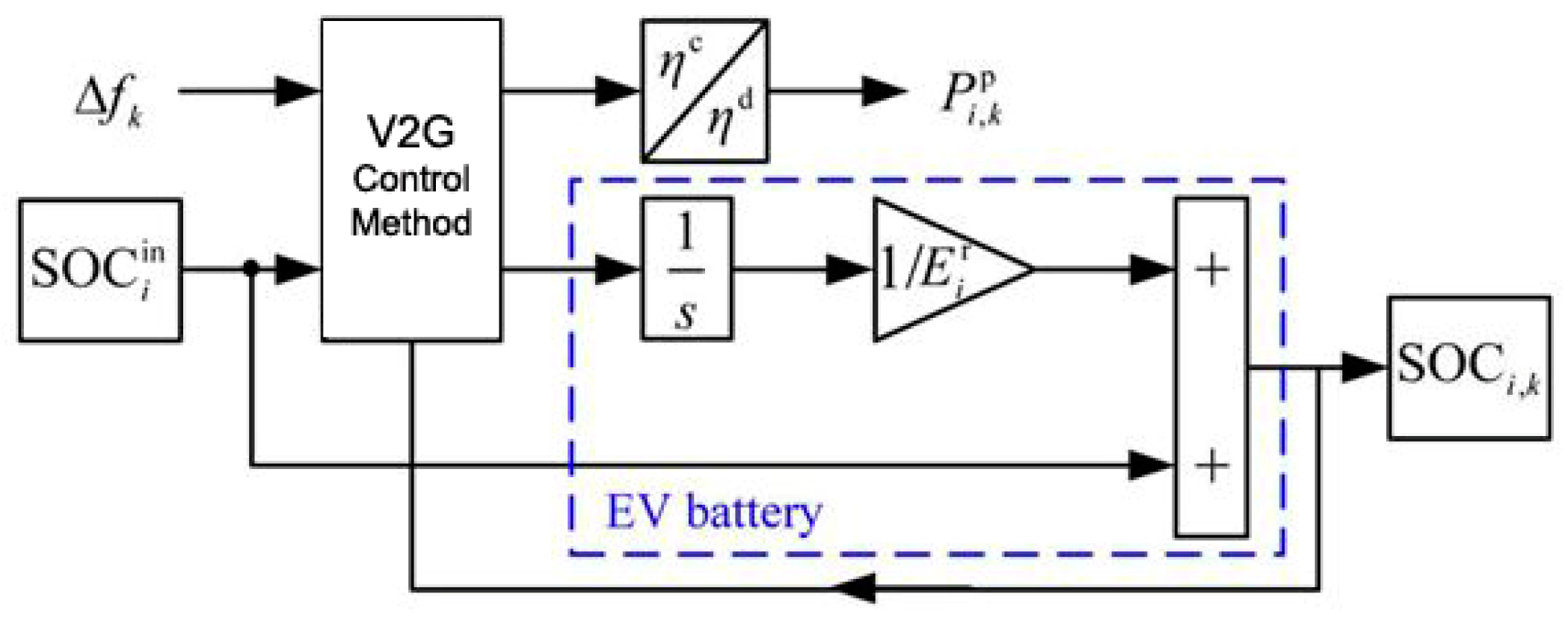

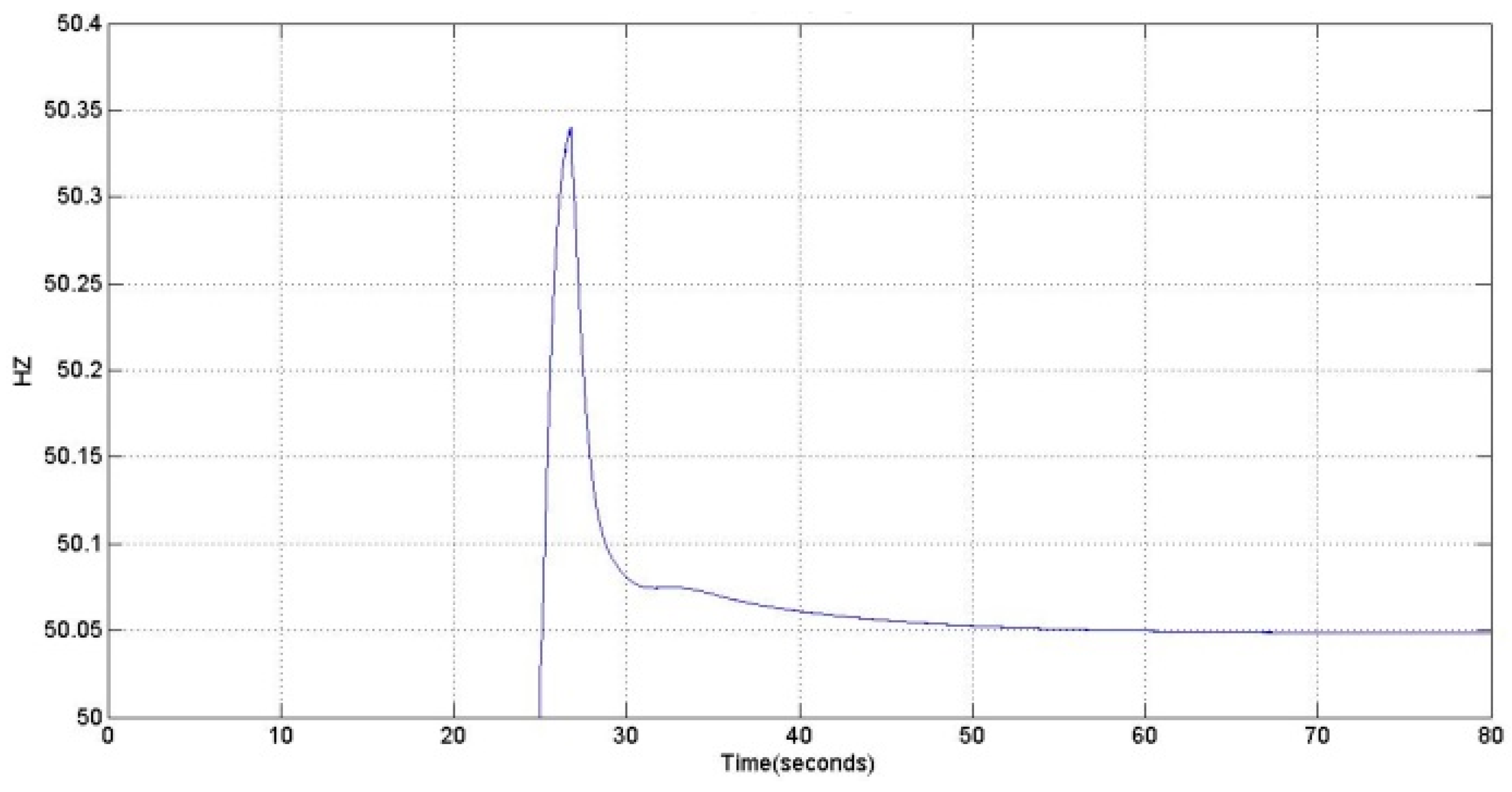
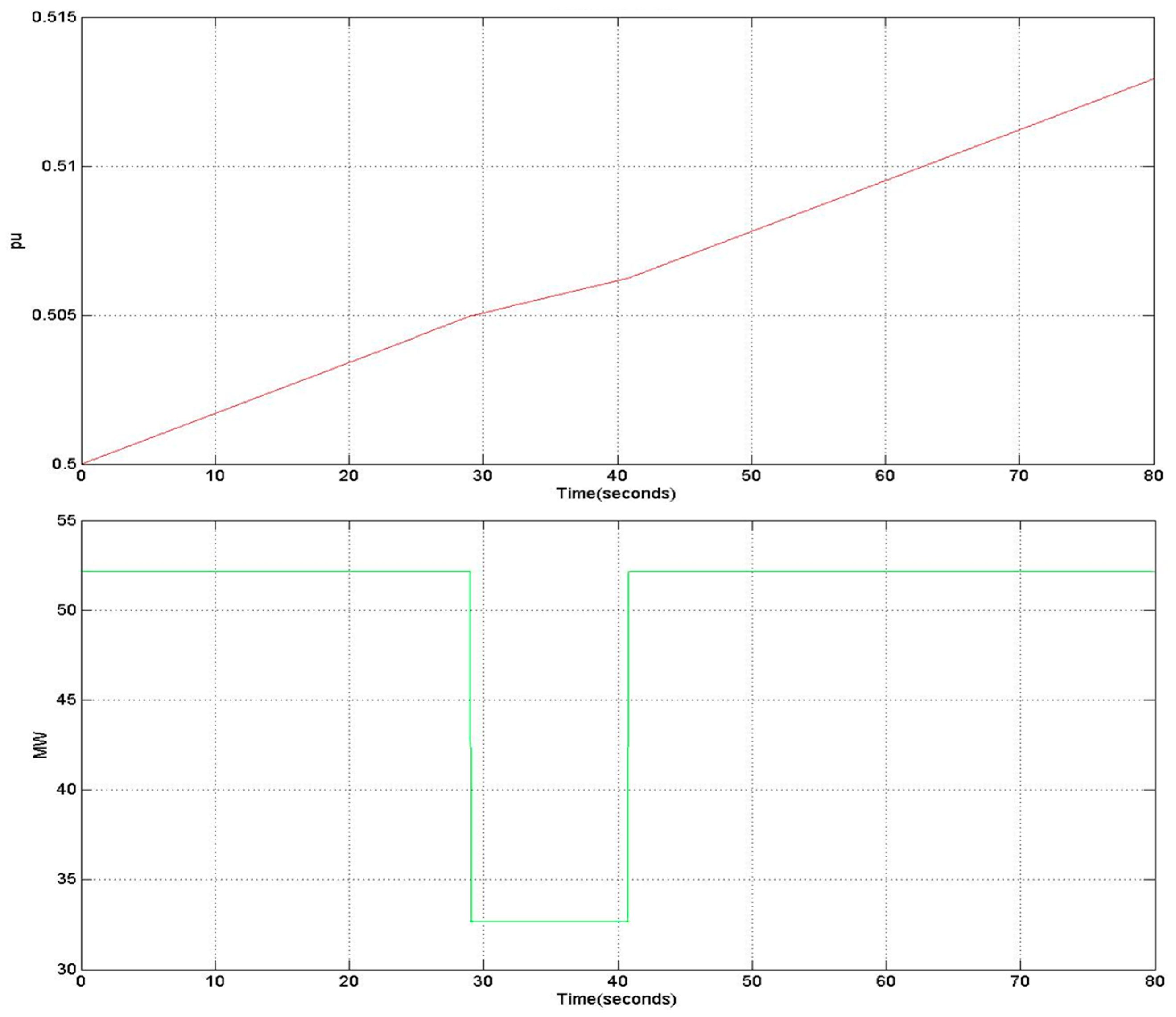

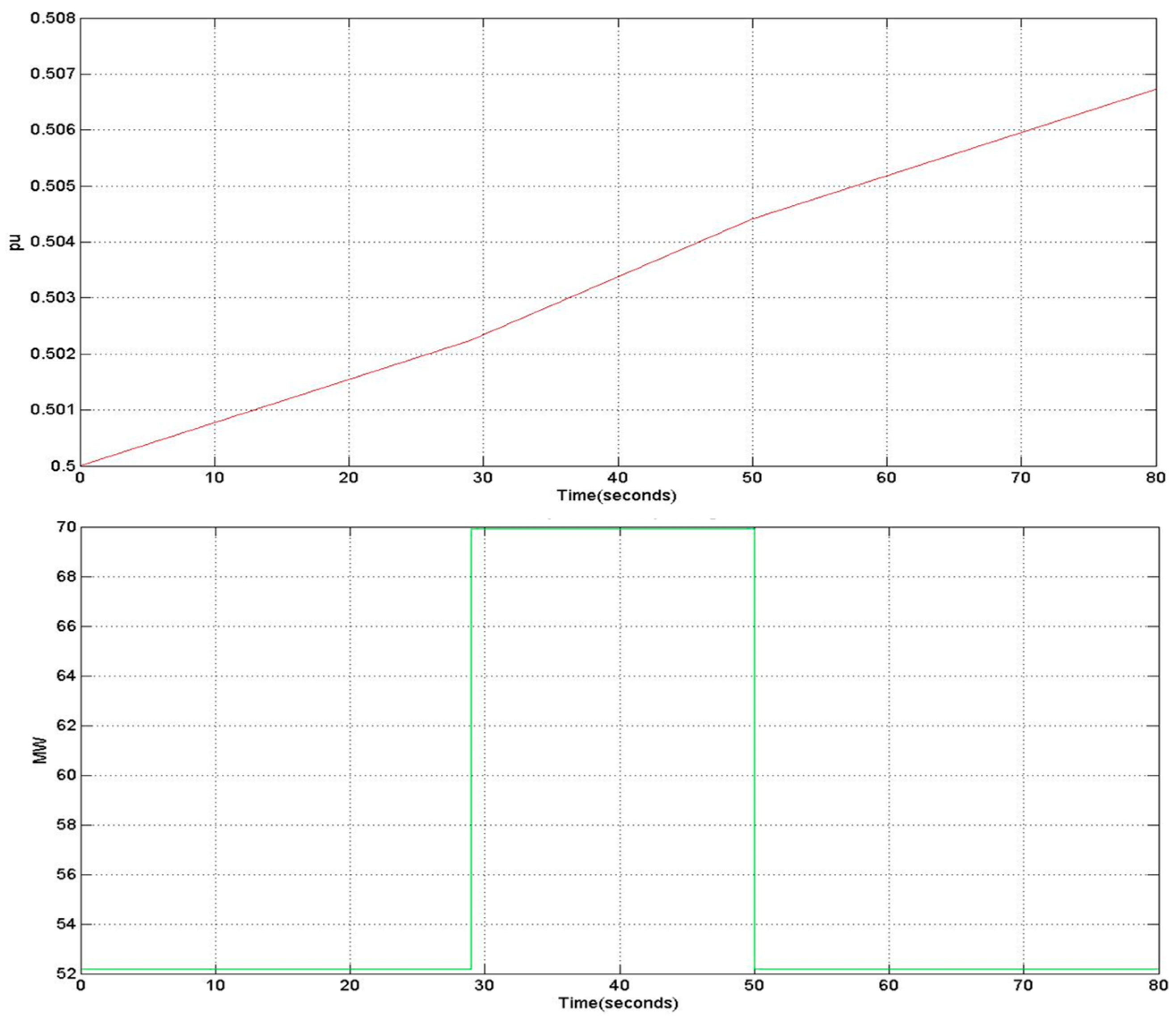

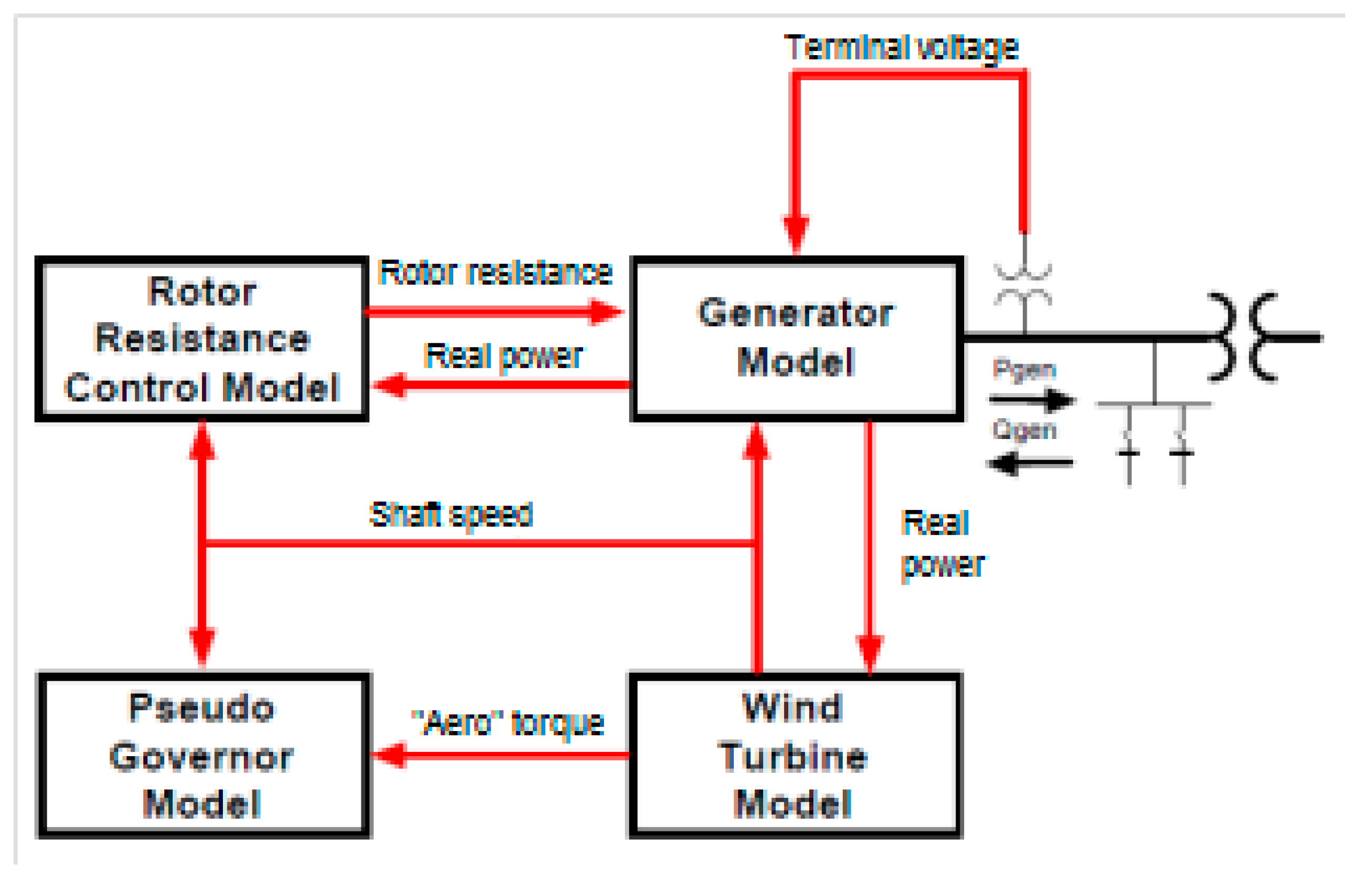

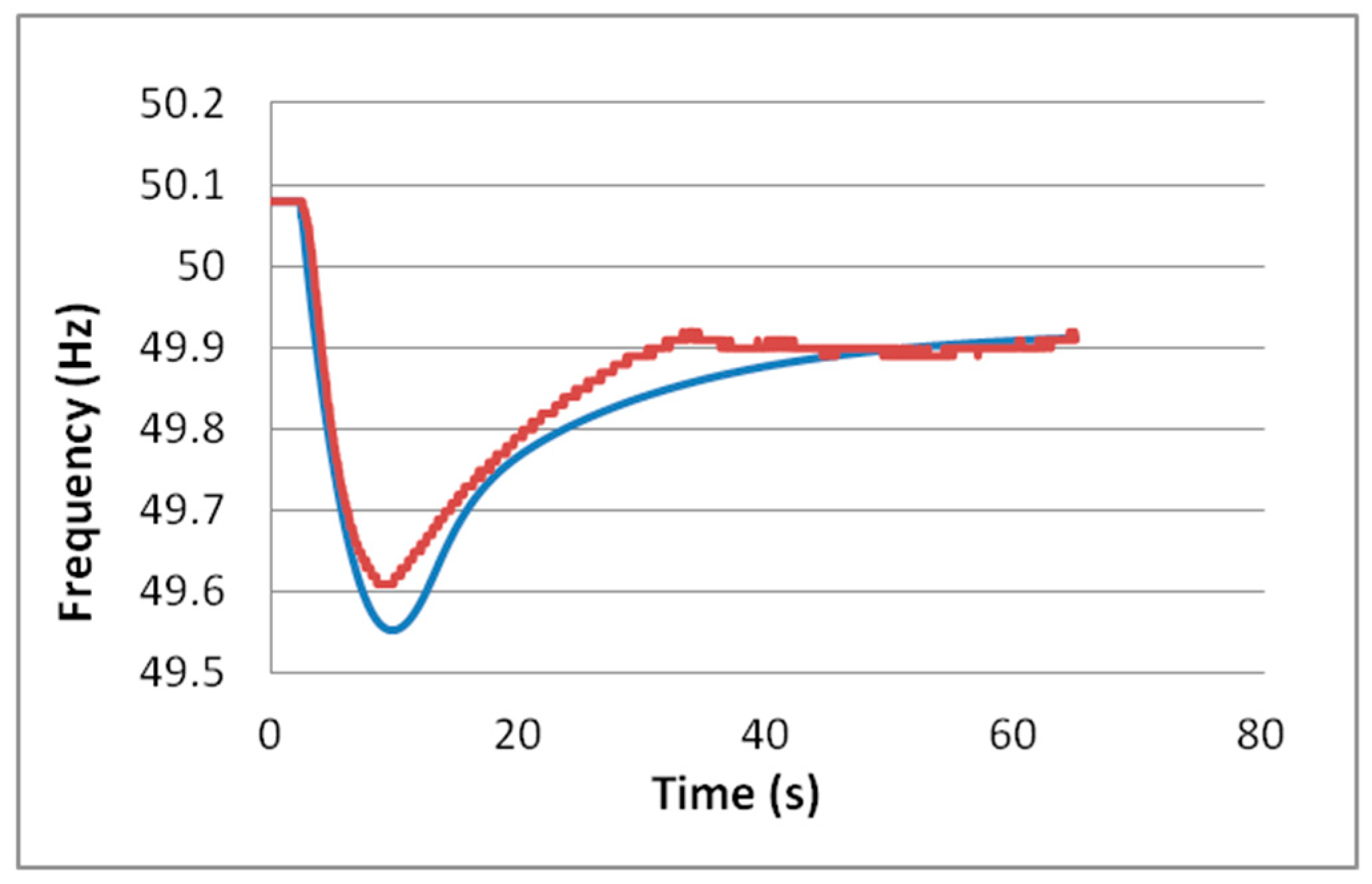
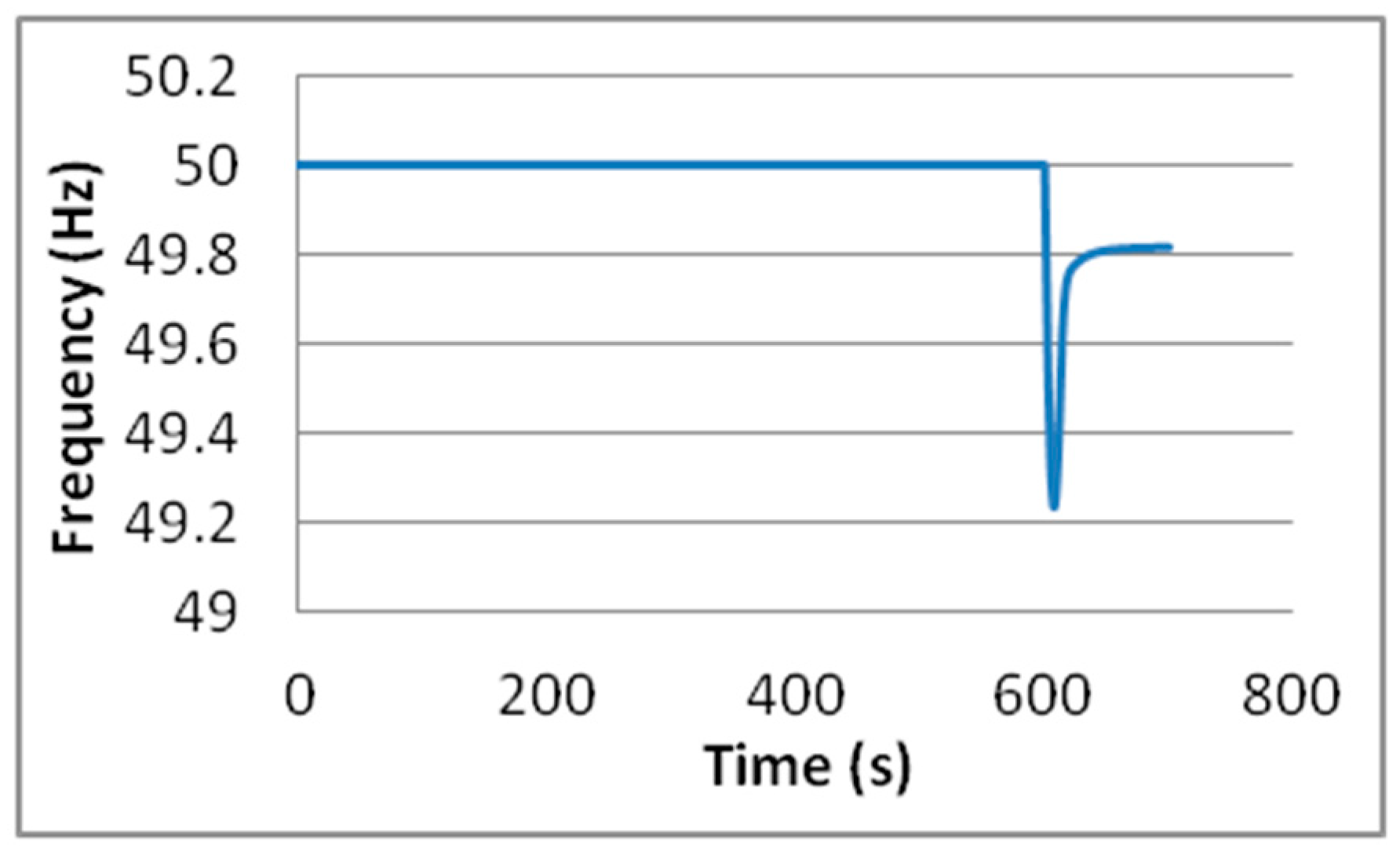
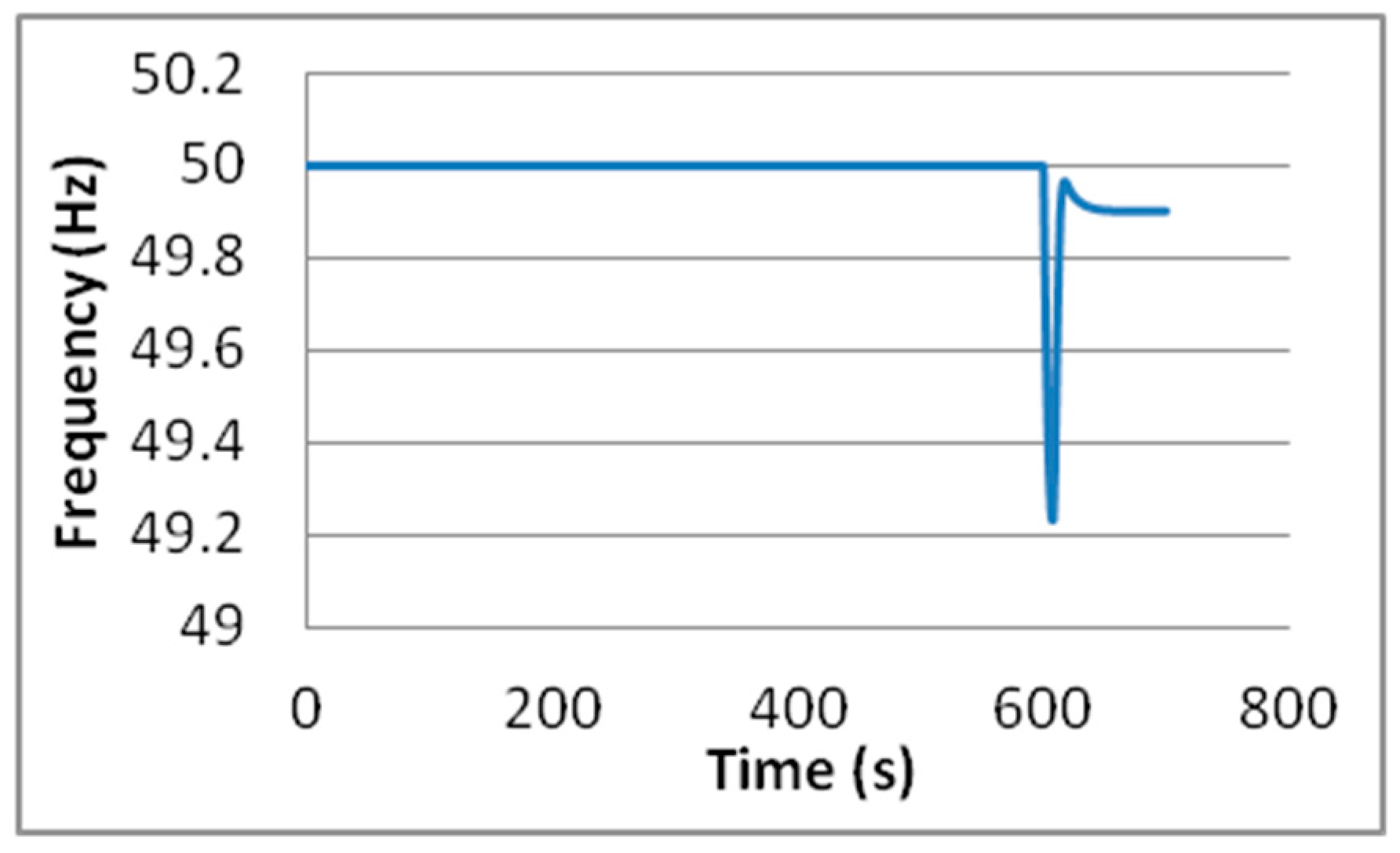
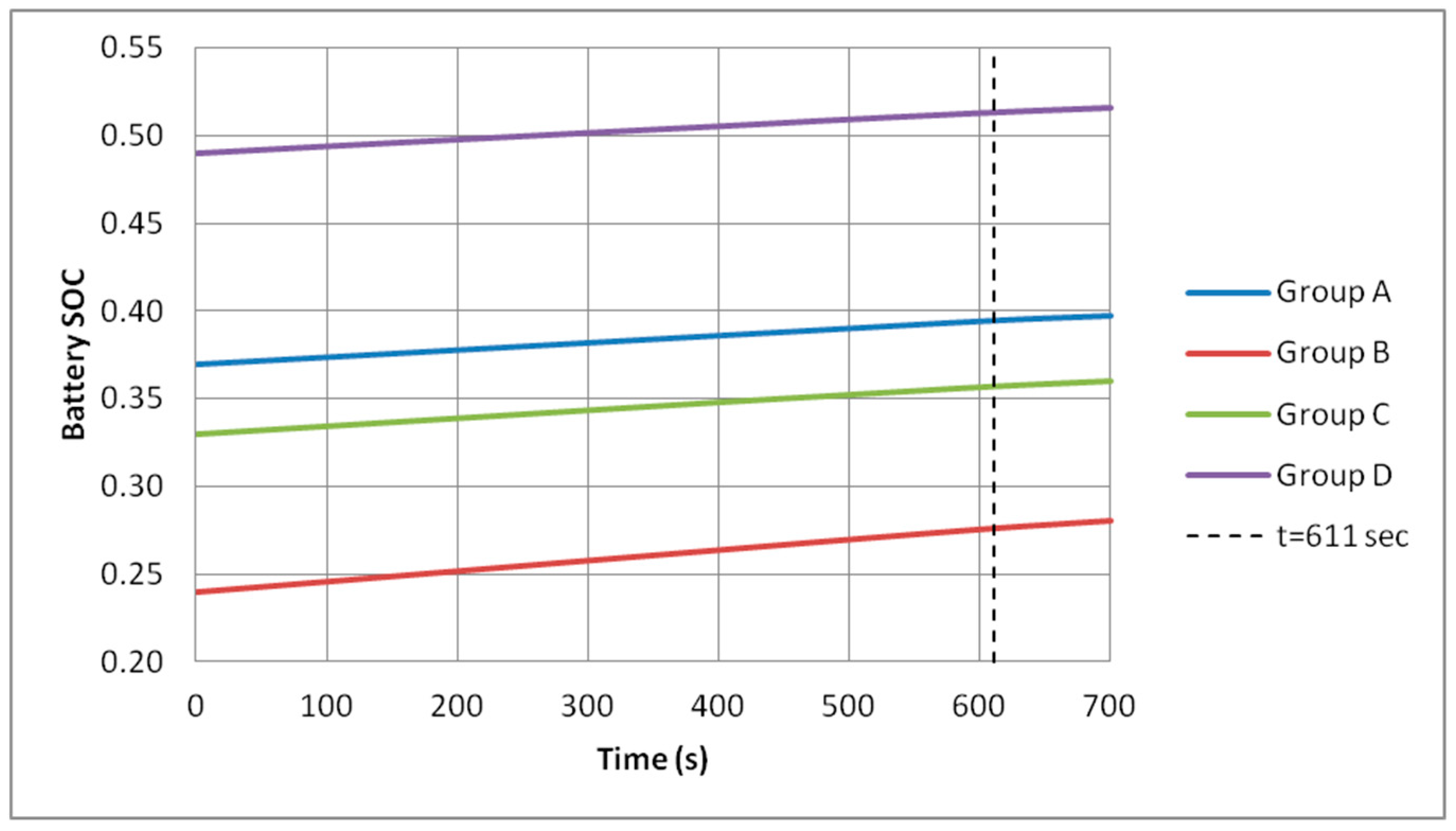
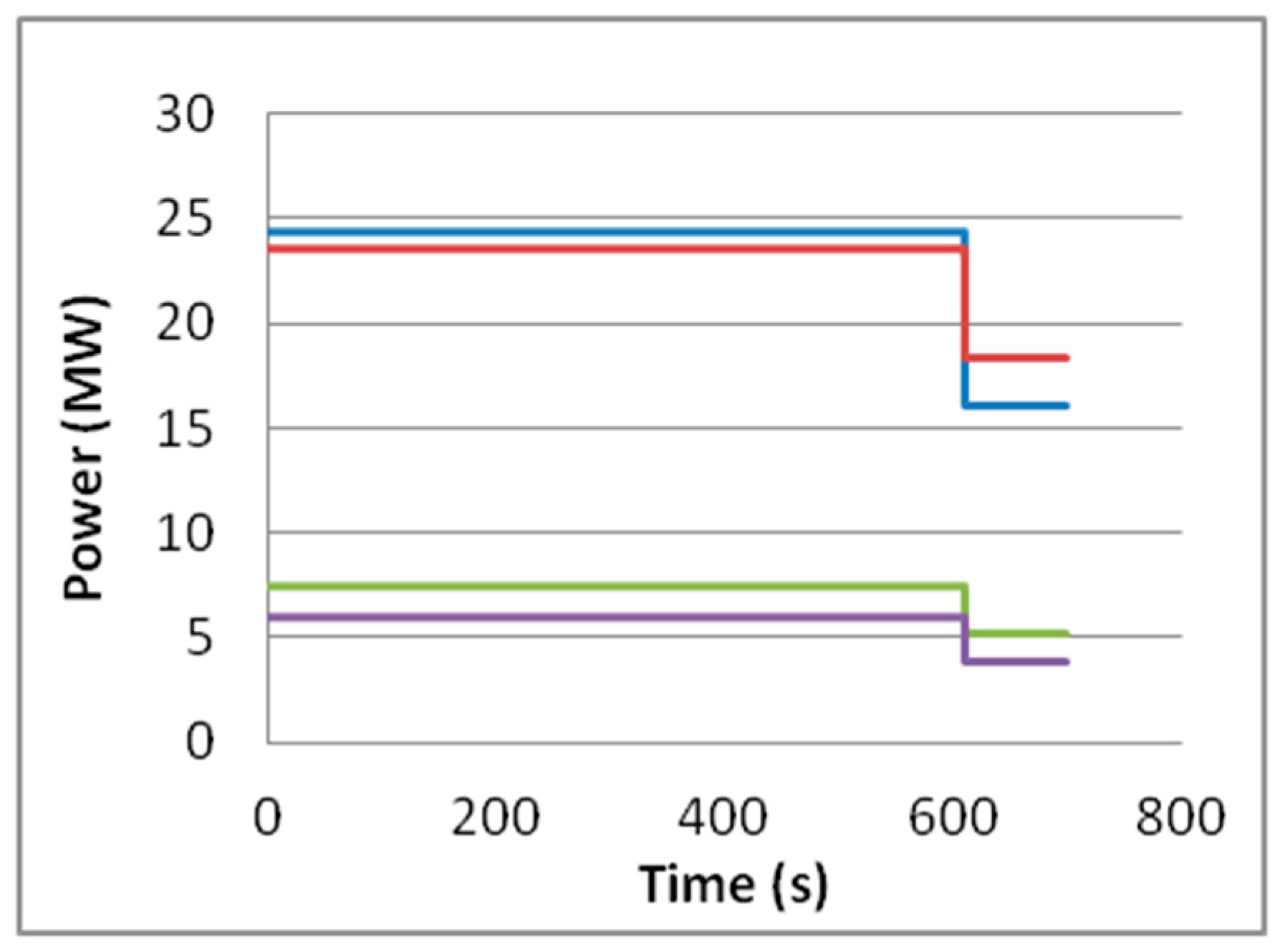
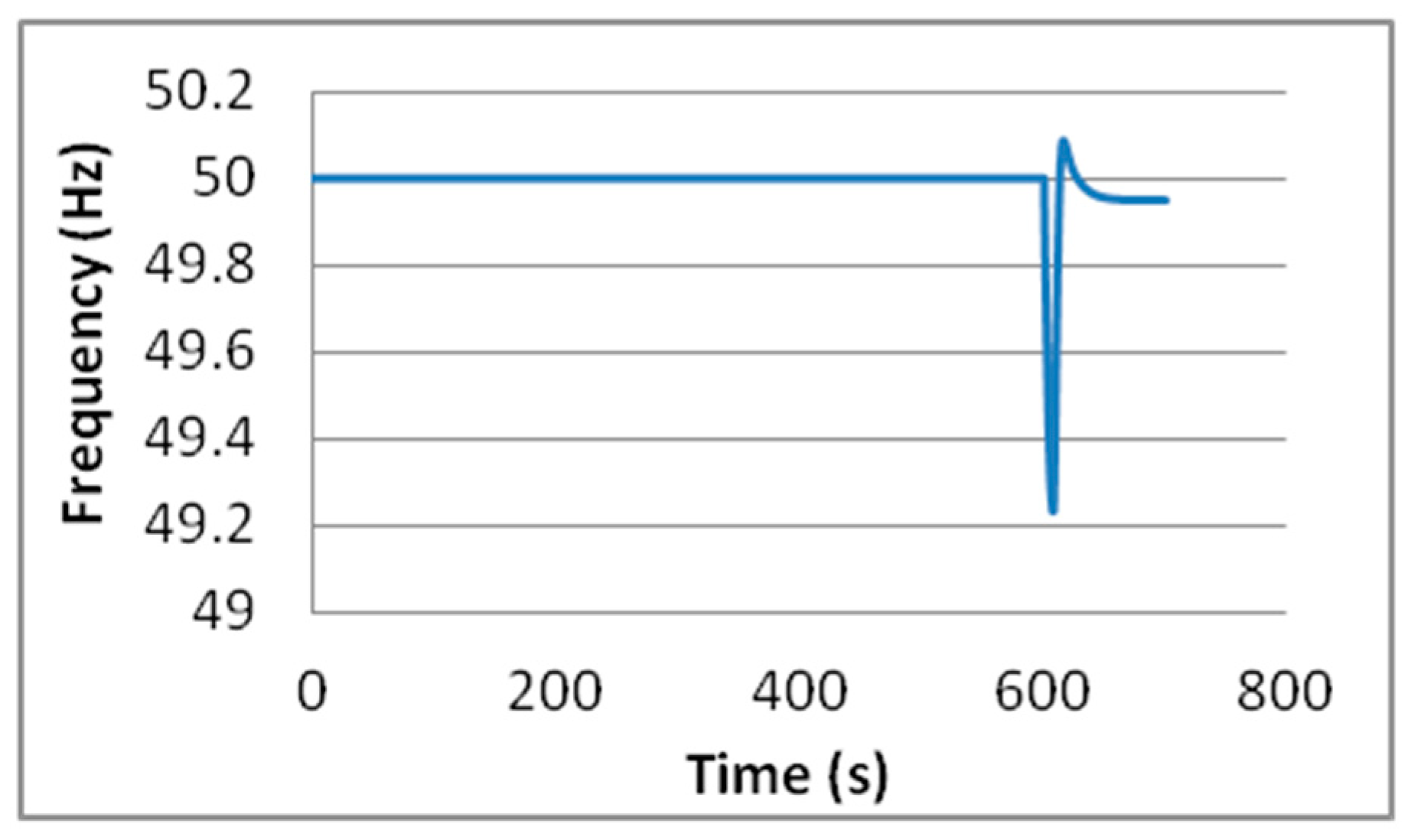

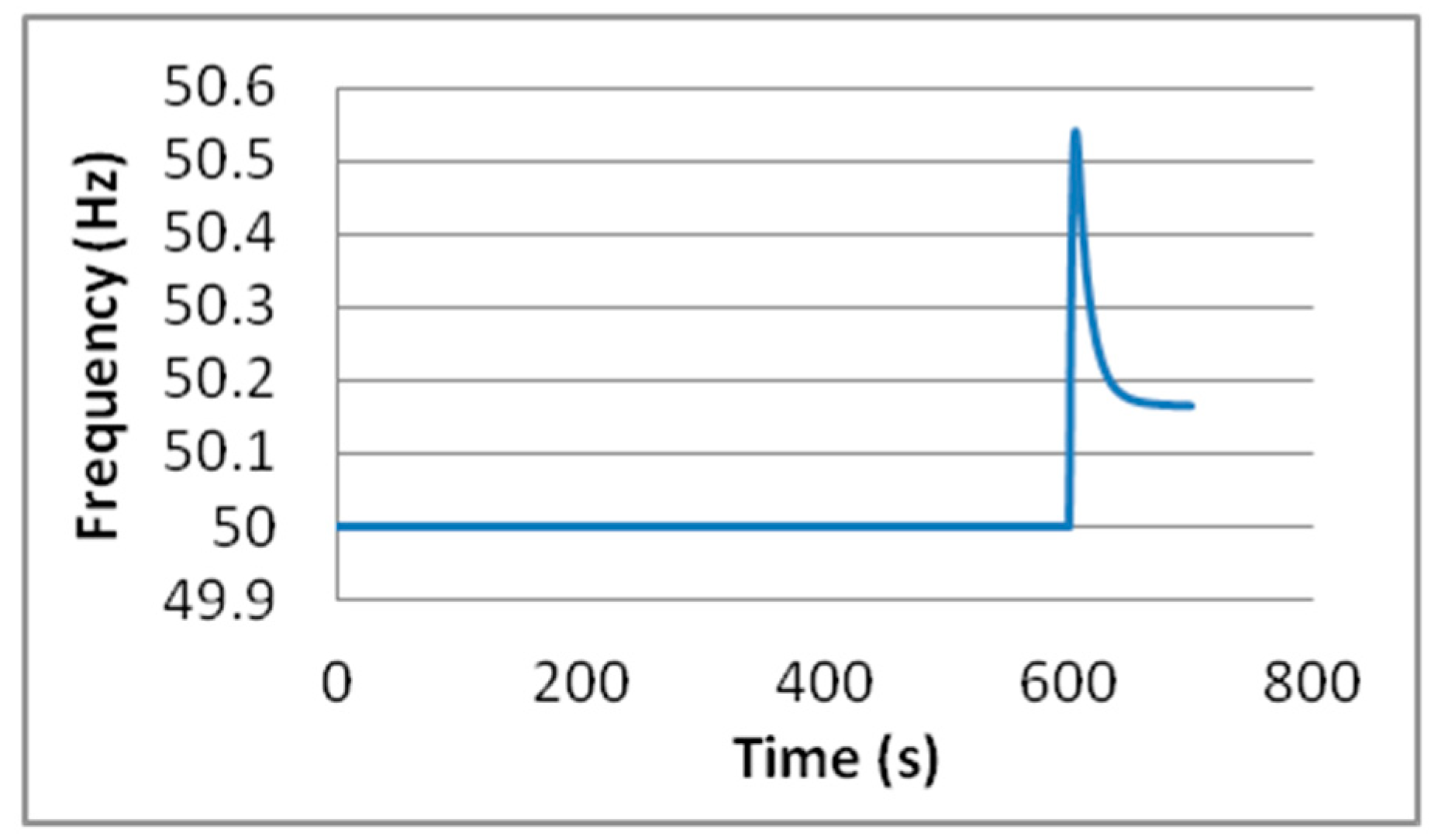


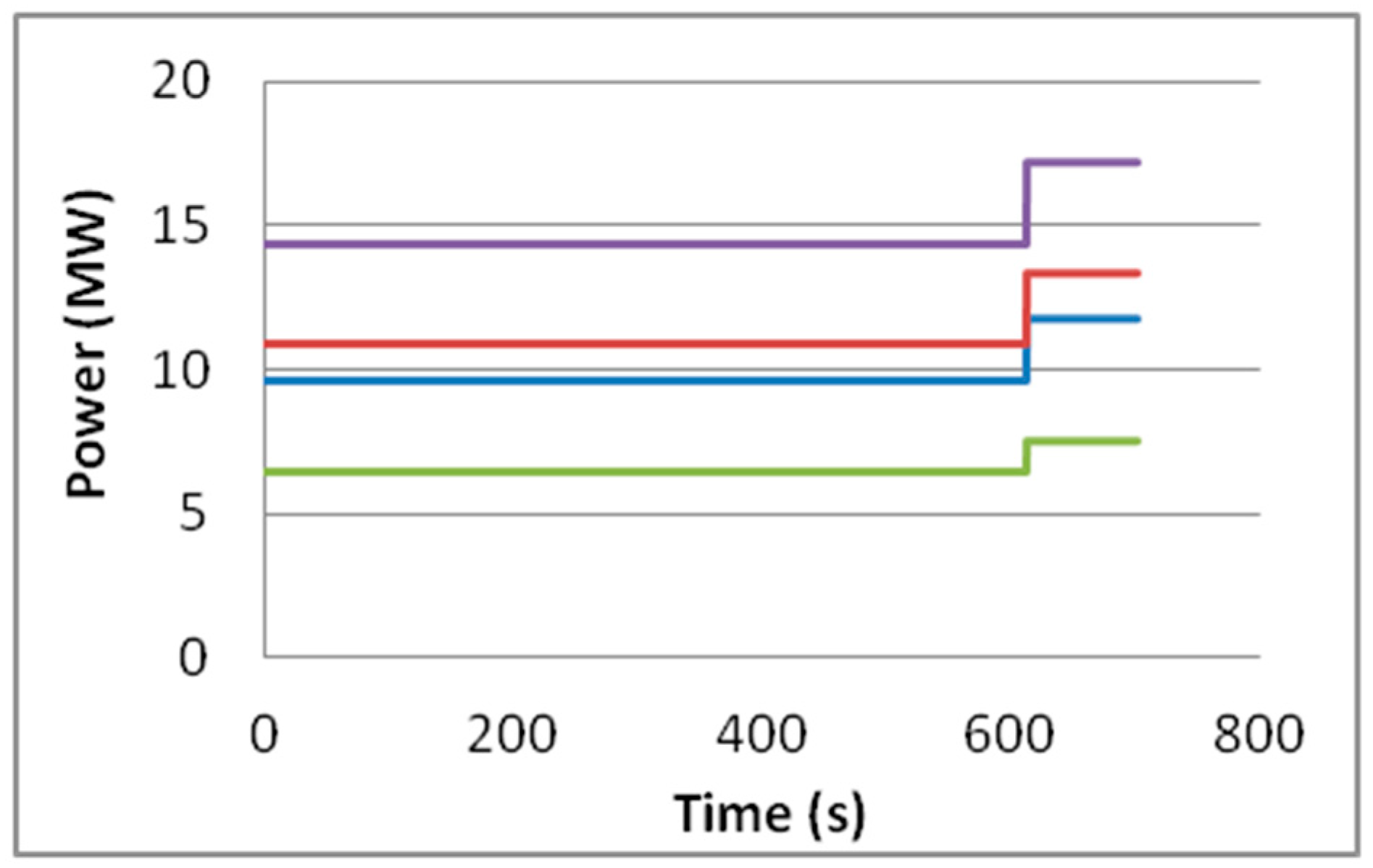
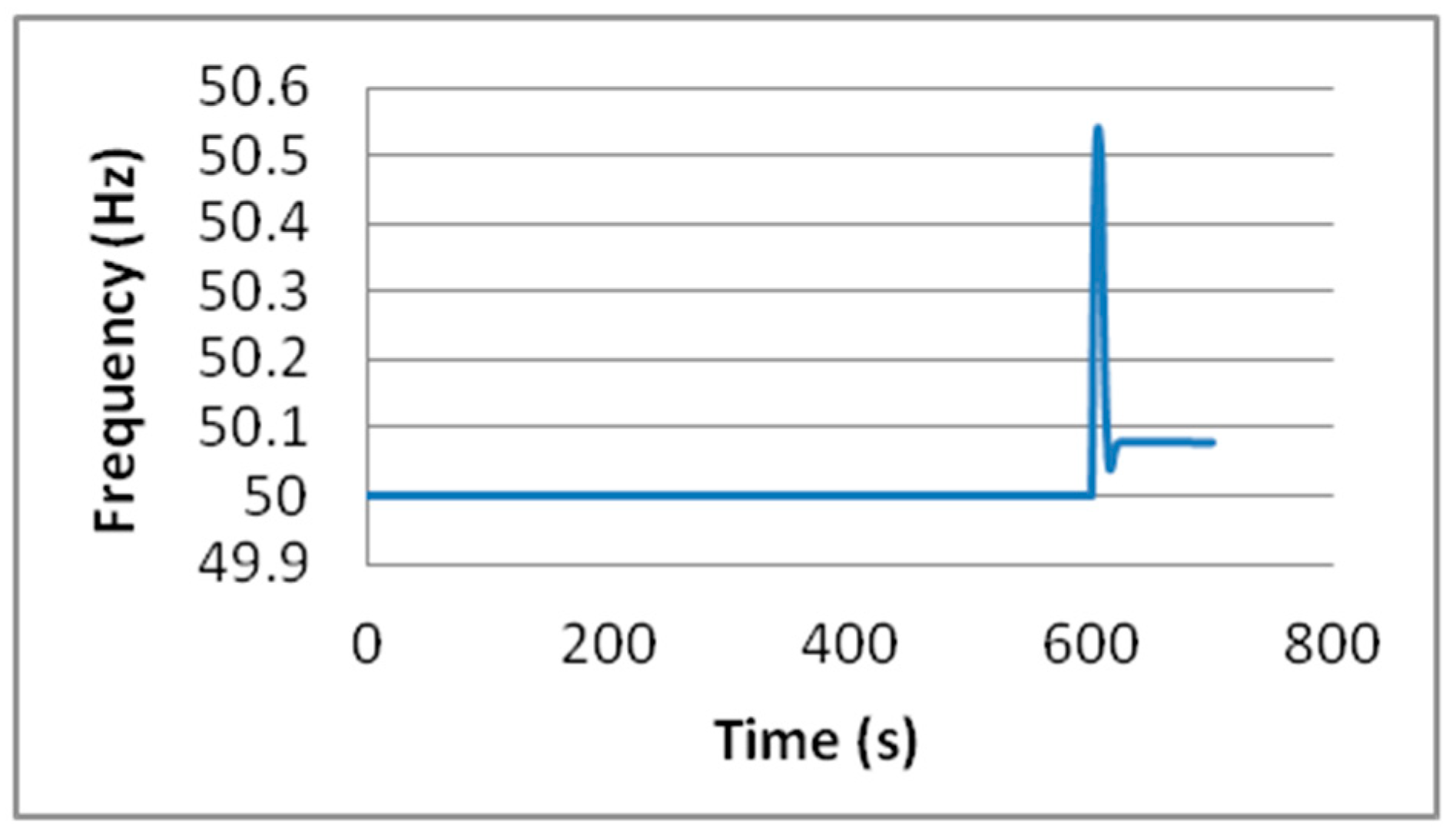


| Parameter | Measurement Unit | Value |
|---|---|---|
| PHEV number | 15000 | |
| Maximum V2G droop | kW/Hz | 3.2 |
| Battery capacity | kWh | 32 |
| Maximum SOC | pu | 0.1 |
| Minimum SOC | pu | 0.9 |
| Maximum V2G power | kW | 7 |
| Frequency dead band | Hz | [−0.05, 0.05] |
| Charging/discharging efficiency | pu | 0.92/0.92 |
| LFC delay | s | 4 |
| Power Station | Generation Unit | Unit Load (MW) |
|---|---|---|
| Vasilikos | Steam turbine-ST1 | 120 |
| Steam turbine-ST2 | 116 | |
| Steam turbine-ST3 | 0 | |
| Combined cycle-CCGT1 | 173 | |
| Combined cycle-CCGT2 | 0 | |
| Gas turbine-GT1 | 0 | |
| Dhekelia | Steam turbine-ST1 | 0 |
| Steam turbine-ST2 | 0 | |
| Steam turbine-ST3 | 0 | |
| Steam turbine-ST4 | 30 | |
| Steam turbine-ST5 | 0 | |
| Steam turbine-ST6 | 30 | |
| Internal combustion-ICE1 | 0 | |
| Moni | Gas turbine-GT1 | 0 |
| Gas turbine-GT2 | 0 | |
| Gas turbine-GT3 | 0 | |
| Gas turbine-GT4 | 0 | |
| Wind generation | Wind turbines | 37 |
| Total system load | 506 | |
| City/District | Group/PHEVs | SOCin (%) | SOCout (%) | Pc (kW) | Total Pc (MW) |
|---|---|---|---|---|---|
| Nicosia | A/7095 | 37 | 80 | 3.153 | 56.493 |
| B/4473 | 24 | 90 | 4.84 | ||
| C/2005 | 33 | 80 | 6.446 | ||
| D/1851 | 49 | 90 | 3.006 | ||
| Limassol | A/2667 | 35 | 80 | 3.300 | 37.839 |
| B/3093 | 46 | 90 | 3.226 | ||
| C/1387 | 32 | 90 | 4.253 | ||
| D/3519 | 39 | 90 | 3.740 | ||
| Larnaka | A/2654 | 13 | 70 | 4.180 | 28.545 |
| B/1942 | 17 | 90 | 5.353 | ||
| C/1036 | 29 | 70 | 3.006 | ||
| D/840 | 26 | 90 | 4.693 | ||
| Famagusta | A/305 | 38 | 80 | 3.080 | 11.071 |
| B/1041 | 12 | 80 | 4.986 | ||
| C/762 | 15 | 70 | 4.033 | ||
| D/432 | 21 | 80 | 4.326 | ||
| Pafos | A/1294 | 39 | 80 | 3.006 | 14.633 |
| B/1941 | 22 | 70 | 3.520 | ||
| C/601 | 27 | 70 | 3.153 | ||
| D/786 | 45 | 80 | 2.566 | ||
| Total load on the system (MW) | 148.581 | ||||
| Power Station | Generation Unit | Unit Load (MW) | |
|---|---|---|---|
| W/O PHEVs | With PHEVs | ||
| Vasilikos | Steam turbine-ST1 | 102.4 | 100 |
| Steam turbine-ST2 | 102.4 | 100 | |
| Steam turbine-ST3 | 102.4 | 100 | |
| Combined cycle-CCGT1 | 165.43 | 186.5 | |
| Combined cycle-CCGT2 | 165.43 | 186.5 | |
| Gas turbine-GT1 | 4 | 32 | |
| Dhekelia | Steam turbine-ST1 | 37.799 | 55 |
| Steam turbine-ST2 | 37.799 | 55 | |
| Steam turbine-ST3 | 37.799 | 55 | |
| Steam turbine-ST4 | 37.799 | 55 | |
| Steam turbine-ST5 | 37.799 | 55 | |
| Steam turbine-ST6 | 37.799 | 55 | |
| Internal combustion-ICE1 | 0 | 0 | |
| Moni | Gas turbine-GT1 | 20.379 | 19 |
| Gas turbine-GT2 | 20.379 | 19 | |
| Gas turbine-GT3 | 20.379 | 19 | |
| Gas turbine-GT4 | 0 | 0 | |
| Wind generation | Wind turbines | 75 | 75 |
| Total system load | 1005 | 1167 | |
| City/District | Group/PHEVs | SOCin (%) |
|---|---|---|
| Nicosia | A/2000 | 86 |
| B/1898 | 65 | |
| C/1745 | 74 | |
| D/1857 | 52 | |
| Limassol | A/1236 | 71 |
| B/1248 | 53 | |
| C/1265 | 89 | |
| D/1251 | 74 | |
| Larnaka | A/1107 | 59 |
| B/1157 | 82 | |
| C/1124 | 53 | |
| D/1112 | 57 | |
| Famagusta | A/944 | 69 |
| B/990 | 64 | |
| C/1039 | 58 | |
| D/1027 | 66 | |
| Pafos | A/1016 | 64 |
| B/1001 | 58 | |
| C/986 | 65 | |
| D/997 | 61 | |
| Total PHEVs | 25,000 |
© 2019 by the authors. Licensee MDPI, Basel, Switzerland. This article is an open access article distributed under the terms and conditions of the Creative Commons Attribution (CC BY) license (http://creativecommons.org/licenses/by/4.0/).
Share and Cite
Neofytou, N.; Blazakis, K.; Katsigiannis, Y.; Stavrakakis, G. Modeling Vehicles to Grid as a Source of Distributed Frequency Regulation in Isolated Grids with Significant RES Penetration. Energies 2019, 12, 720. https://doi.org/10.3390/en12040720
Neofytou N, Blazakis K, Katsigiannis Y, Stavrakakis G. Modeling Vehicles to Grid as a Source of Distributed Frequency Regulation in Isolated Grids with Significant RES Penetration. Energies. 2019; 12(4):720. https://doi.org/10.3390/en12040720
Chicago/Turabian StyleNeofytou, Neofytos, Konstantinos Blazakis, Yiannis Katsigiannis, and Georgios Stavrakakis. 2019. "Modeling Vehicles to Grid as a Source of Distributed Frequency Regulation in Isolated Grids with Significant RES Penetration" Energies 12, no. 4: 720. https://doi.org/10.3390/en12040720





